Archive for May, 2012
May 31st, 2012 by dave dorsey
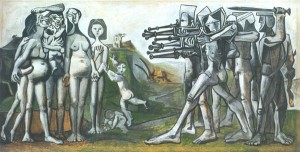
Picasso's Goya
I got two thoughtful responses, via email, to my posts about Arthur Danto. Rick Harrington reacted as a practitioner suspicious of theories divorced from the actual practice of art. I agree that theory ought to arise as a response to art, not the other way around. (Tom Wolfe, in The Painted Word, suggested that in the middle of the 20th century, criticism began to be the basis of a lot of art, rather than a response to it—and, as conceptual art began to emerge, his notions seemed to be confirmed. Art can often becomes little more than the illustration of an idea. Once you understand what’s being conveyed, you’ve exhausted the act of looking at it.) Yet Rick is saying something more practical, that an artist creates out of a struggle to make a work of art in a certain way, physically and emotionally, and if that means working in ways artists from previous eras have worked, then it’s a perfectly vital way to create art. To prohibit any attempt to immerse oneself in past art and internalize it, and even to try to create art in the same way as previous artists, seems like hubris on the part of a critical theorist. To say it’s pointless to paint as Caravaggio painted, using his techniques, would ignore the work of an artist who might have something illuminating to offer by doing just that. Superficially, the work might look anachronistic, yet it might also seem alive and rich because of that. Dave Hickey, in The Invisible Dragon, talks about distinguishing what an artwork embodies, in its formal qualities, and what it denotes or signifies—the meaning a work of art assumes in one age can be transformed when future generations look at it with new eyes, but what remains the same, and what enables it to endure, is what it embodies, the craft and physical qualities of the work that continue to convey the same indefinite energy and awareness to a viewer. Great work stays alive from one era to the next, precisely because of its formal qualities, not because of what it is assumed to mean. In other words, the work’s beauty survives its ostensible significance to a particular generation. And because of that, a new generation can find new “meaning” in the image. I think Rick is suggesting something similar. Danto, it seems to me, equates the forms of previous art with their meaning, as if a Byzantine mosaic must mean only one thing to a viewer, and was most meaningful only within a certain historical period, and has no value whatsoever to a 21st century Buddhist, say. Rick says, More
May 30th, 2012 by dave dorsey
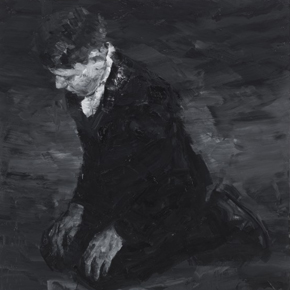
Pablo, Yan Pei-Ming
David Zwirner’s gallery is first on my list whenever I’m in the city, and he rarely disappoints. His current show, Black Paintings, by Yan Pei-Ming, expands this Chinese artist’s ambitions, which until now seem to have centered mostly on large-scale portraiture. He was unable to achieve an education in art in his native China, and he moved to Paris to study painting, where he has remained and has found himself swept into international art fairs, high-priced sales for his work at auction, and even a small conceptual-looking installation of his paintings at the Louvre. Nice work if you can get it. In 2009, he exhibited his portrait of Obama at Miami Art Basel. Last year, his portrait of Mao sold for half a million pounds in London, with bidders from 11 different countries. And only a few days ago, Zwirner unveiled Yan’s portrait of Lady Gaga at the Hong Kong International Air Fair. Hey, nobody’s perfect.
With this new show, Yan’s reached much further than before, and he’s succeeded. These heroically scaled paintings—they feel as wide as a movie screen—are done in his typical grisaille, and in this new show he’s taken the values down into Tonalist territory, as dark as you can get and still depict something, with subjects almost obscured by the enveloping gloom. His vigorous brushwork brings to mind Lucien Freud, Natalie Frank’s portraits, even Jenny Saville, if she traded her flesh tones for oils pigmented with charcoal. Ostensibly inspired by Goya’s late wall paintings, which include visionary scenes and nightmarish depictions of horrific and occult subjects, these paintings seem even more liminal than the Spanish master’s. Up close, you recognize almost nothing but an impenetrable ocean of paint, and it’s a rough, choppy ride for the eye, from any angle. But the further back you stand, the more the images slowly resolve into life. The artist’s previous work has had political overtones, and it’s present here in Ghadhafi’s Corpse and his near-copy of Goya’s Execution and even in his apocalyptic painting of crows, if you look long enough to recognize the setting. Yet the Goya pastiche reproduces that collective murder in a void, with no indicators of time or place. The three paintings that form the heart of this show seem to take his anxieties to a spiritual precipice: his portrait of Picasso as a penitent young man, a depiction of a lifeboat adrift at sea, and a storm of crows swirling and darkening a night sky in Athens. All Crows Under the Sun are Black! feels like a scene Hitchcock might have crafted for his version of the Book of Revelations: oppressive and inexorably foreboding. The end of something enormous is at hand, or the beginning– Democracy itself (depending on where you live) given the Parthenon tucked into shadow under that sky. The horror he shows you seems near and alluring in a weird way and maybe is an expansion on his image of the Arab Spring. You want to slip into that image and find a place to hide, or participate. In Moonlight, he seems to have offered a slightly more hopeful version of Gericault’s Raft of the Medusa, a lifeboat tossing in the sea with the beacon of an oncoming rescue vessel on the horizon. It’s oddly uplifting, unlike its predecessor, which feels like a melodramatic summer blockbuster by comparison. With his portrait of Picasso, he’s envisioned the artist as a young man on his knees, his head bowed, apparently dressed for a ceremony, obedient and humble. It’s the most interesting image in the show. This legendary alpha dog of visual art is posed as a servant or vassal or devotee; and this is a man who probably represents for most of us the paradigm of the artist as a someone who lives by his own rules, governed only by his self-assertive male prerogatives. Instead, Picasso here is seated on his knees in a supplicant pose, hands placed carefully on his legs, his gaze averted, as if he’s waiting for instruction or an inner rescue or blessing. These paintings are as large as anybody’s ego, yet that spectacular scale is undercut in every way. The images are vulnerable and understated, with a reverence for uncertainty and the unknown, and they offer only enough information for the imagination to do most of the work. They feel like an almost unwilling personal exposure: exactly the way Goya’s Black Paintings did, meant only for his own eyes and no one else’s. These few images, together, have a tremendous impact, both emotional and imaginative, and as black as they are, they aren’t oppressive, but thrilling. They balance horror with a life-affirming awe, and the despair they seem to embody has to contend with a far more interesting and artistically defiant note of transcendence.
May 29th, 2012 by dave dorsey
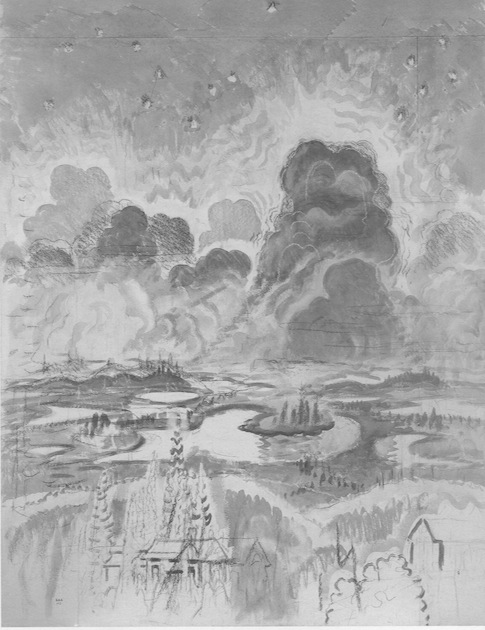
Heat Lighting, Charles Burchfield
Having just finished rereading After the End of Art, by Arthur Danto—I quoted from it in my previous post—I remember why I had such mixed feelings about this book the first time I read it. The history of art is over, and we’re now free to do anything we like. That seemed to be his vision, through most of his book. If a work is visible, it can be considered art. So anything is possible. Yet, in his last chapter, he suddenly lowers the boom and says that yes, visually, anything goes, but that doesn’t mean that we’re free to do anything at all. Essentially, you can work with styles and tropes from the past, but you have to put it all in brackets: it has to be ironic. If it looks exactly like a Rembrandt, and it was painted last year, call someone for some emergency deconstruction. Namely, someone with Danto’s credentials.
The sense in which everything is possible is that in which all forms (of visual art) are ours. The sense in which not everything is possible is that we must still relate to them in our way. The way we relate to those forms is part of what defines our period . . . one can without question imitate the work and the style of the work of an earlier period. What one cannot do is live the system of meanings upon which the work drew in its original form of life. Our relationship is altogether external, unless and until we can find a way of fitting it into our form of life.
That last phrase sort of opens up all the possibilities again, in a sneaky way: “unless we can find a way of fitting it into our form of life.” Well, duh. These passages I’ve quoted above strike me as incredibly awkward attempts to dance around the phrase “form of life” as a way of remaining true to the postmodern orthodoxy. There is no universal truth; there are no eternal verities in human life. We’re all simply living through a period in which fleeting cultural forces have shaped our behavior and thinking, and we need art that addresses these temporary economic, social and sexual realities, unique to our time, until they are gone and the work we’ve done becomes a fading way of making sense of our “form of life.” So, Danto at first says that history is essentially over, for art: artists are liberated to do absolutely anything and call it art. (Whether it gains cultural traction through the respect and admiration of others is another question.) Yet then he reverses himself and says artists can’t simply make art the way previous artists did, because that “form of life”—ancient Athens, say, or Renaissance Italy or ancien regime France—no longer exists and the art of that period represents its own matrix of meaning that has no application in our postmodern world. In one More
May 26th, 2012 by dave dorsey

Arthur Danto
My friend and fellow painter, Jim Mott, once asked Arthur Danto if it was okay to paint landscapes again. It makes me laugh to write that, and I’ll bet it made Danto laugh to hear it, or at least smile. I don’t think Jim seriously thought he needed Danto’s permission, but he got a nice and predictable reply: “Yes, it’s okay to paint landscapes again.” Or do anything else and call it art, for that matter, as Danto points out in After the End of Art. Jim also got a bonus observation from Danto that Jim’s project as an itinerant artist was also a bit of performance art, with the landscape painting as only one element of the endeavor. It isn’t every day you get a favorable comment on your work from Arthur Danto. Or any day, for most of us. One passage from the book I just mentioned stands for me as justification for what I do as a painter, in the way Danto’s reply to Jim’s query works as an argument in favor of what Jim does in his painting. The passage I’m posting here ofers a wonderful, concise overview of why the pursuit of the New in art makes no historical sense anymore, though the experience of seeing with new eyes will always remain, for me, the goal of painting:
The history of Western art divides into two main episodes, what I call the Vasari episode and what I call the Greenberg episode. Both are progressive. Vasari, construing art as representational, sees it getting better and better over time at the “conquest of visual appearance.” That narrative ended for painting when moving pictures proved far better able to depict reality than painting could. Modernism began by asking what painting should do in light of that? And it began to probe its own identity. Greenberg defined a new narrative in terms of an ascent to the identifying conditions of the art, specifically what differentiates the art of painting from every other art. And he found this in the material conditions of the medium. Greenberg’s narrative is very profound, but it comes to an end with pop, about which he was never able to write other than disparagingly. It came to an end when art came to an end, when art, as it were, recognized that there was no special way a work of art had to be. The history of art’s quest for philosophical identity was over. And now that it was over, artists were liberated to do whatever they wanted to do. Paint lonely New England houses or make women out of paint or do boxes or paint squares. Nothing is more right than anything else. There is no single direction. There are indeed no directions. And that is what I meant by the end of art when I began to write about it in the mid-1980s. Not that art died or that painters stopped painting, but that the history of art, structured narratively, had come to an end.
May 16th, 2012 by dave dorsey
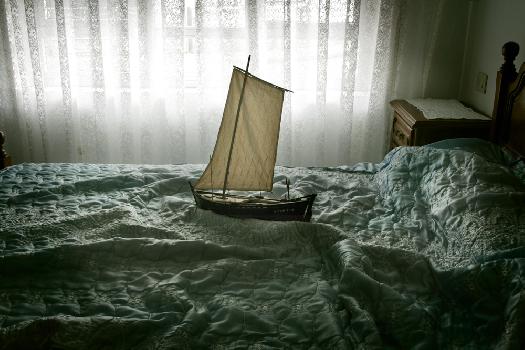
Luis Gonzalez Palma
May 16th, 2012 by dave dorsey
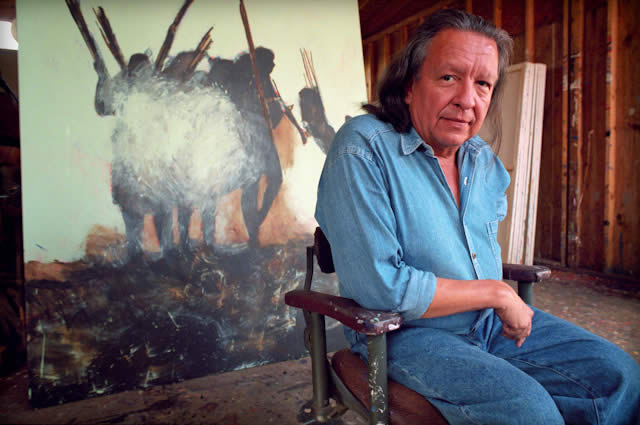
My good friend Donna Rose at artbrokerage.com sent me a link to a wonderful interview with her favorite art teacher, Fritz Scholder, who died a few years ago. It ranges all over the place, and it’s all refreshing. Some samples:
- All kids draw. I never stopped. I was real shy, and all I wanted to do was stay in my room and draw, so I wouldn’t have to deal with people. This, at the time, was difficult. But in retrospect, I always knew what I had to be. There was never any question. It was all that I could do. Plus, I was a rebel, right from the beginning. If someone told me to do something, I’d do the opposite. So I was, in a way, a bad boy in school . . . . You have to realize that at times art was really pretty foreign. For most people, an artist meant going to Paris and starving in a garret. No one was making a living in this country, except for Georgia O’Keeffe and Thomas Hart Benton. And so, what one did was to get degrees and teach at a university, and if you were good, you might be able to get an artist-in-residency. So, it was pretty bleak to think that you could be an artist.
- Picasso would paint way into the night. He’d wake up at two in the afternoon, and he always woke up grumpy. Françoise Gilot had to be there when he woke up and hear the same litany every day. “Oh, I feel terrible! It’s a terrible day. I have no friends. Matisse hasn’t written to me.” And he would go down the line. More
May 15th, 2012 by dave dorsey
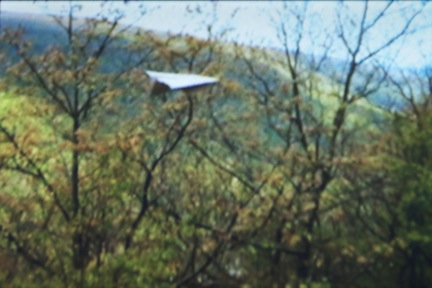
My seed-laden airplane in the Finger Lakes
As I sit in our family room with the laptop, I watch robins and chickadees land on our brick patio to gather bits of burlap and downy seeds and fibers from temporary flowerpots, and then fly off to build nests. We’ve got a lot of nests in our yard this year, and two catbirds yesterday were opening flapping around in our birdbath, which I’ve never seen before in the two decades I’ve lived in the Rochester area. Normally those slender gray birds are secretive, shy and usually stick around enough for only a quick drink.
It’s been looking like a great year for birds around here, so that’s partly why, yesterday, I drove down into the Finger Lakes, and found my way to an overlook above one of the gorgeous valleys that surround the Canandaigua area, about an hour south of where I live, and I tried to launch some of Jennifer Wenker’s paper airplanes into the great wide open of a sunny spring day. She’d made the paper by hand, impregnating the pulp with wildflower seeds. I’d been hoping to film the slow descent of my aircraft to the bottom of the valley, but the wind—as I’d feared—was not going to let it happen. Not matter how I aimed them, they made a sharp turn and headed north or south, along the line of the hills, or else they did a U-turn and flew back over my head. One made it far enough down to do the job it was made to do—dissolve in the rain and let the seeds drop into the soil and germinate. Ultimately maybe a few of the seeds will provide food to birds in the area. That the idea, anyway.
It happened to be the morning of Mother’s Day when I did all this, and I hadn’t thought of it at the time, but the act of launching these seeds was a mothering thing to do: trying to offer food to smaller, more vulnerable creatures. It was also my first act as a performance artist. In a way, Jennifer’s project is an open-ended invitation for anyone to become a conceptual/performance artist on behalf of the environment. She makes the paper. But it’s up to you to fold it into an airplane and sail it off toward some receptive patch of soil where it might grow into food for birds whose resources for nutrition grow scarce in places where farming and lawns and human landscaping have taken over. Jennifer made the airplanes as a project to complete her MFA at University of Cincinnati this year. She was inspired to create this campaign in response to a USDA program for poisoning “nuisance birds”: “Bye Bye Blackbird” in which, she says, 2 billion birds were poisoned in 2009.
My attempts to get planes to fly accurately into places where their payload could sprout taught me a few things I’m sure Jennifer had in mind when she hatched this project. First of all, you become aware of how resistant the land is to any incursion of new life, at least when it’s the cargo of small triangular aircraft. It gets stuck in the little twigs. It flips around and lands on gravel. It snares in tall grass. Most of the soil is already occupied—and a sunflower or thistle seed has to be lucky to drop into a tiny patch of available, sunlight topsoil. And that was in the wild of a New York State park. I came home and decided to aim another plane directly into a berm in our backyard where all sorts of untended and usually unwanted things will often grow. But it was, proportionally, a very small area in what is essentially a homestead packed with grass, flowers, trees, or mulch. Even so, plants still appear where I least expect them. I see how seeds can find places to grow on their own every year: strawberries that pop up in the brick walk to our front door—somehow having made their way from behind the garage—or new Shasta daisies three or four feet from the parent cluster. And the weeds always find a way. But the welcome volunteers are few and far between. More than anything else, this project has shown me that I had to drive quite a way to find a place open enough for the seeds I was offering. The closer you get to home, the more you realize how other forms of life often have to find a way to live despite the presence of people.
May 14th, 2012 by dave dorsey
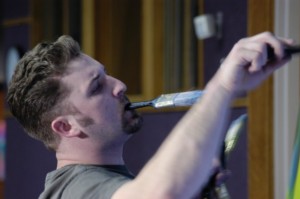
Rush Whitacre
Next week, I’m going to visit Brooklyn one more time to help Rush Whitacre load up his pickup and head back to his home and studio in Ohio. He’s had his fill of New York City. I’ve gotten to know Rush well since we met last summer. He offered the use of his truck to Viridian Artists, where I show my work, when the gallery moved to its new location on 28th St. in Chelsea. He had me laughing that first day, and he’s kept me laughing every time we’ve met since then. I’ve described him before: tall, massive, with blondish-brown hair and a cropped beard. He wouldn’t have looked out of place sitting next to Joe Namath in a lounge somewhere back in the 70s. Yet Rush doesn’t pretend to convey that kind of cool: he’s a guileless hugger, who brings out the nicest qualities in the other people around him, always trying to make someone else a little happier while he’s around. (Often, this involves the consumption of beer, though not always.) In a way, his entire approach to life is anti-Cool. He’s extremely intelligent, and yet he doesn’t impose any of it on anyone else. Just before his move to Brooklyn, he finished his Ph.D. in fine arts at the University of Cincinnati and, as I’ve pointed out before, he has a total of five college degrees, including ones in biology and bio-chem. He’d rather come across as the happy, enthusiastic midwestern country boy who listens to Taylor Swift and paints huge sunflowers without a whiff of postmodern irony.
I’m disappointed that Rush is leaving, but I don’t think he came to the city in order to break into the art scene. He seemed to be using his year to absorb as much art as he could and return with a large inventory of memories and photographs for teaching back in Ohio. On my last visit I let him use my Nikon D40, and we plowed through most of the galleries at the Metropolitan, where he shot nearly 300 images for use as teaching aids if he gets the job he hopes he’ll land for More
May 13th, 2012 by dave dorsey
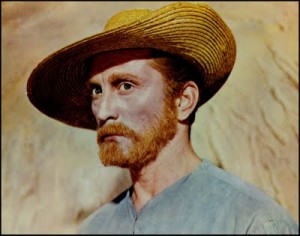
Being a painter generally means feeling like an object of curiosity or affectionate sympathy—I do admire his work, love the guy, but how does his wife put up with him? Sometimes I think I’m looked upon with vague suspicion, as if my street’s property values will immediately edge down if word gets out about what I do with my time. Making a painting doesn’t strike most people as work. It’s fundamentally irresponsible, usually requiring other sources of income, and is essentially a strenuously sedentary form of play. Like, say, high-stakes poker. No sweat is involved, but money can be made, though not very often and only by a few of the luckiest practitioners.
There are other problems. Those of us who devote long hours to the act of painting tend to hang together, forming little suspect coteries of marginality—grown men and women who want to make pictures, dress in age-inappropriate ways, or gender-inappropriate ways, or species-inappropriate ways, and usually earn less than enough to make ends meet. We look at one another and think, yep, she has the disease too, thank God, because it means I’m not alone. I see Richard Dreyfuss sculpting a mountain with his mashed potatoes at the dinner table in Close Encounters of the Third Kind, as his children weep with the conviction that daddy has gone bonkers, and I say, Keep going, keep going, Roy, it will all make sense in the end! But I wonder. Will it? So I hang out with fellow artists and drink beer and talk about how badly other people handle their paint, or how amazing Richter is when you see his actual canvases, or how so-and-so is a clever sell-out—and in the end we go our separate ways and feel more energized, but just as alone. Because the solitude is essential, even if sometimes intolerable. You have to isolate yourself and work on self-imposed deadlines for a solo show where months or years of labor may go up and come down with only one or two sales, no reviews, and maybe much less praise than you’d hoped to get. And then, after these necessary bouts of doubt and loneliness, you rush to hang out with other artists again and talk your way toward 3 a.m., hoping that the friendships will support you, emotionally, until you arrive More
May 5th, 2012 by dave dorsey

Not sure what, or if anything, all those little figures mean–or how many Chinese workers it took to make them, probably–but this is just cool, even though that fed-up Ph.D., whose rant I liked a lot, in my previous post might question whether or not it’s worth anything as art. More Gormley work at http://www.mymodernmet.com/profiles/blogs/remarkable-geometric-human-figures and http://www.mymodernmet.com/profiles/blogs/antony-gormley-field.
May 4th, 2012 by dave dorsey

From “I’m Sick of Pretending. I Don’t Get Art.” from someone with a Ph.D. in art:
“You know what? I’m sick of pretending. I went to art school, wrote a dissertation called “The Elevation of Art Through Commerce: An Analysis of Charles Saatchi’s Approach to the Machinery of Art Production Using Pierre Bourdieu’s Theories of Distinction”, have attended art openings at least once a month for the last five years, even fucking purchased pieces of it, but the other night, after attending the opening of the new Tracey Emin retrospective at the Hayward Gallery, I’m finally ready to come out and say it: I just don’t think I “get” art.”
Read the rest here: http://www.vice.com/en_uk/read/im-sick-of-pretending-i-dont-get-art










